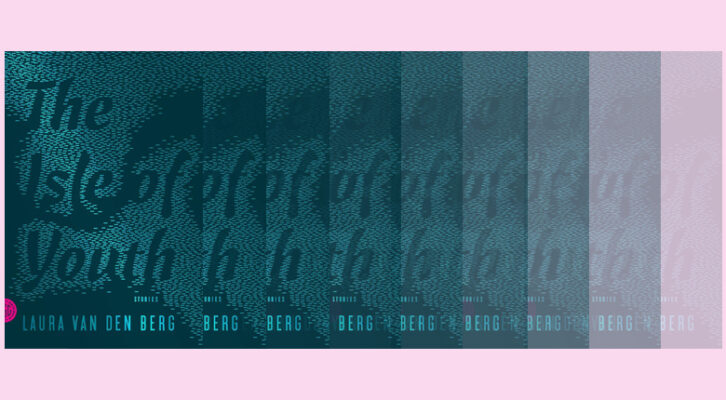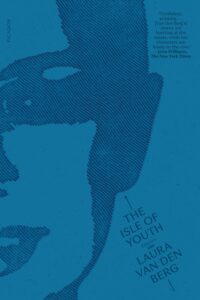
Ten Years Later: Reading Laura van den Berg’s Timeless Classic, The Isle of Youth
Kyle Dillon Hertz on the Book That Guided His Ambition to Be a Writer
A decade ago, I wanted to be known for writing. I dropped out of massage school, couldn’t get into college, and began taking online writing courses through adult education programs. We read Raymond Carver, James Baldwin, Denis Johnson, Lorrie Moore. You know the list, and I bet you too heard the common wisdom: read everything.
All this brought me to Laura van den Berg’s The Isle of Youth, the first collection that existed ready in my mind as I read it, a book so cool and mysterious I recognized it as kin, despite the fact that I was a gay San Diego stoner who warped the pages with the Pacific and ashed into the binding. The fact that the author herself was young and innovative guided my ambition unlike the other dead greats.
The opening story, “I Looked for You, I Called Your Name,” was my favorite. Honeymooners crash land in Patagonia, enduring a catastrophic vacation. The narrator becomes estranged and disturbed by her husband’s reactions to each accident, leading her to act mysteriously and searchingly, watching a woman swim in the ocean at night before stuffing her own mouth full of sand.
Finally, fire overtakes the hotel on the last night. The narrator’s surface quiescence is betrayed by her risky private actions, and staged gorgeously by van den Berg’s use of contrasting settings, like her brief description of the Iguazú falls: “Water poured over two massive cliffs and pooled in a huge expanse speckled with mossy rocks, as though a lush island had just been overtaken by a flood. And then there was the sound, the deep rushing noise that burned away the confusion and the worry.”
Many of her characters keep animating secrets from the people who love them. A wife had a twin, once. A private investigator with an incarcerated father and derelict mother seeks out danger. Following her brother’s explosive death in an Antarctic research station, a woman attempts to understand why he died, and if his missing wife’s secrets played a role. A twin disappears into a criminal life in the Isle of Youth. If you are lost in the world, keeping secrets, and looking for answers that elide you—this is the book.
At this point, writers saying that they write to explore questions, not give answers, is a cliche. The more I write, the more I work, the more I want to ask other writers: well, what do you mean by this lofty statement? In Mystery and Manners, Flannery O’Connor writes that “evil is not simply a problem to be solved, but a mystery to be endured.” This idea provides a good understanding for how we might think of the broken worlds of millennial fiction, where the world itself is substituted for evil characters. Laura van den Berg displaces the reader in a world to be endured, and the feeling this creates is mysterious since what lurks isn’t an evil within people but within the system that guides the hand of the gun, which may find your temple in the dead of a Florida night.
Laura van den Berg displaces the reader in a world to be endured, and the feeling this creates is mysterious since what lurks isn’t an evil within people but within the system that guides the hand of the gun, which may find your temple in the dead of a Florida night.
Ten years after I discovered The Isle of Youth, FSG is reissuing it, collection cover-to-cover, again. When I asked Laura van den Berg about The Isle of Youth, she wrote, “I have such a clear memory of finishing The Isle of Youth in a friend’s near-empty apartment in Baltimore. They had moved and left a lease early, generously offering a quiet work space for a few weeks while my own apartment building was overtaken by noisy construction.
I had been struggling to finish a novel and felt, at the moment, that I had failed; I was adjuncting at a bunch of different schools and, after a frantic semester, was desperate to return to fiction, to do something that could restore faith in my own creative possibility. I remember that apartment as being dead quiet. I remember the scary-wonderful feeling of stretching beyond things I had attempted in the past. I remember that I still smoked and would crawl up a fire escape and have a cigarette on the roof to close out the work day.
I remember that the steam of the Baltimore summer made me feel closer to home. I had been told by so many people that it was one thing to debut with a story collection but no one—literally no one—wanted a writer’s second book to also be a collection of stories. So I worked on the book with the understanding that the world of the collection might only ever exist in my imagination.”
Normally, in my writing classes, I assign the opening story, which stuns some students the way it did for me. Except I wasn’t just stunned by beauty. I was mirrored, a starry, seagazing secret-keeper myself, who “acted inexplicably” and wanted to “show them the truth because the truth was meant to be seen, not just released in the middle of the night” but because I hadn’t been truthful with everyone around me I would act in ways that mystified even myself, and I had to “lay out the contents on the bed like evidence and try to understand what it was that was going to be lost.”
Back then, I thought the book just rode shotgun to Capital M mystery because I thought the reason I acted strangely was because I was unknowable. But I really just didn’t know myself yet. Danger attracted me, tacitly acknowledgment of the sexual violence of my teenage years. It should not shock when I say that I loved benevolent controlling men, like my first husband, to whom I had read passages from The Isle of Youth in the deathly heat of Palm Springs before he realized he hated me for my confounding attempts at getting the truth of what happened to me out of my own locked interior. I cheated and lied and screamed and escaped, and I found it all so mysterious. That’s youth. That’s grief, which is the collection’s underlying condition.
I understand now why I took so strongly to these stories.
In “Antarctica,” the narrator visits the research station where her brother died in a base explosion, and the subplot involves his wife, Eve, who had once been held captive for three days in a basement by a man who goes to prison for his crimes against her. In the captor’s sick old age, Eve says she needs to visit him in the hospital to speak to him. Following the unseen visit, the captor dies and Eve disappears. The narrator withholds her role in the encounter from everyone, including her brother, who never finds out the details surrounding his wife’s disappearance. The narrator learns from a scientist that there was a chance her brother could have escaped.
Maybe he chose to be engulfed. Out there, in the elements, you could fall through the ice into a subglacial lake and lose or limb or get caught in a whiteout and lose two fingers to frostbite. You could burn in the cold as easily as in the flames. You could disappear into what happens as suddenly as you could be taken, and all you will leave behind is mystery, “the grief of wanting to know what was not knowable…”
The stylistic cohesion between the stories immerses the reader in a strangely atmospheric collection, which has no recurring characters, but motifs of fire and mirrors and siblings and water. In the final story, “The Isle of Youth,” estranged twins reconnect when the troubled Floridian twin calls her sister down to apartment sit for her so she can have one final fling with a married man. She doesn’t want the wife who is following her to be alerted of their sojourn, so by having her twin sister stay in her apartment, they will be able to have their private goodbye. But the affair has ended. And when violent men show up demanding goods that the Boston sister doesn’t know about, she insists they have the wrong twin. But they’ve heard it before. Now, she must await her twin’s return in order to go back to her troubled marriage, to a life that she hoped to temporarily escape, getting a taste of her twin’s abject life.
What if you made the right choices but you still became miserable? What if nothing is wrong but your life is seeming to leave you behind? The stories trap you there, as you watch the women traverse mirrored narratives that seem to deliver the women where they started yet fundamentally changed, an experience that gives the characters answers and an opportunity to change, a wiser exploration of our contemporary interrogative-method of fictive narrative.
Over the ten years I’ve been teaching these stories, I went to grad school, divorced my first husband, sold my book. Now, at thirty-two, about a year since my novel came out, I can look back on my life and see the circuitous trials of a person making sense out of violence, and by that I mean extracting the fear of violence from the actual threat of violence, and separating the life I had once escaped from the safety I had built for myself. I understand now why I took so strongly to these stories.
The process of healing exists long before you are conscious of it, and by the time you have purchase in a state of freedom you might have long been chasing such an existence. This is the difference between what you know and what you are conscious of. That’s why The Isle of Youth is a timeless classic. A decade for me, a decade for the book, as it passes onto a new generation of writers, like my brilliant young student, Ava Hennen, who writes of this book: “I was dumbfounded and electrified all at once. This story makes me foam at the mouth with jealousy, but I’m also filled with immense hope. That maybe I, somehow, could pull this feat off one day. We all have these stories as young writers. I looked for You, I Called Your Name is mine.”
________________________

Picador’s reissue of The Isle of Youth is available now.
Kyle Dillon Hertz
Kyle Dillon Hertz is the author of The Lookback Window, a New York Times Editors’ Choice. His work can be found in Esquire, Freeman’s, and Time, among others. He received his MFA from NYU and a residency from Yaddo. He teaches at The New School.



















